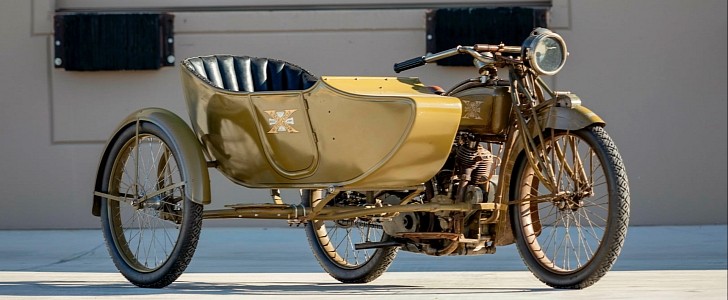World War I era olive drab 1916 Excelsior rocking a 998cc (61 Cl) F-head V-twin engine with 3-speed transmission has only seen 4,900 miles (7,886 km) worth of action. Not too shabby for a 106-year-old bike.
I had one-year-old cars with more digits on the dashboard than that. Speaking about dashboards, what a beauty of a rear sprocket drive speedometer on the Excelsior. Looks more like an elegant Breitling chronograph than anything.
The 1916 Excelsior comes equipped with a sidecar. Well, it says 1916 on the price tag, but in reality, it’s a 1918 model marketed as being two years “younger.” The sidecar wheel and fender slide out just enough to make the car track width fit on era-appropriate roads.
It has an automatic compression release, and upholstery filled with original horsehair. The expression “they don’t make’em like they used to” comes to mind.
Back in the mid-1910s, the Excelsior Motor Company used to advertise its vehicles as “the zenith of motorcycle quality.” With a strong work ethos and clever marketing, the company climbed into the top “Big Three” manufacturers in America, next to Indian and Harley-Davidson.
What’s noteworthy about this 1916 Excelsior is that it launched after the company went through a big internal shift back in 1915. For a decade-long period after that, models like 1916 represented their “flagship.”
For example, this one had underwent a series of evolutions compared to the 1915 Excelsior. It came with new horizontal inlet manifolds, improved cylinder design, relocated spark plugs, enclosed exhaust valve springs, and a new timing case cover.
It also came with the brand’s exclusive dual-operation clutch that could be engaged by a foot pedal or hand lever. However, the most notable feature was the redesigned frame tube above the engine, so that the riders could remove the cylinders without taking the entire thing apart.
The 1916 Excelsior comes equipped with a sidecar. Well, it says 1916 on the price tag, but in reality, it’s a 1918 model marketed as being two years “younger.” The sidecar wheel and fender slide out just enough to make the car track width fit on era-appropriate roads.
It has an automatic compression release, and upholstery filled with original horsehair. The expression “they don’t make’em like they used to” comes to mind.
Back in the mid-1910s, the Excelsior Motor Company used to advertise its vehicles as “the zenith of motorcycle quality.” With a strong work ethos and clever marketing, the company climbed into the top “Big Three” manufacturers in America, next to Indian and Harley-Davidson.
What’s noteworthy about this 1916 Excelsior is that it launched after the company went through a big internal shift back in 1915. For a decade-long period after that, models like 1916 represented their “flagship.”
For example, this one had underwent a series of evolutions compared to the 1915 Excelsior. It came with new horizontal inlet manifolds, improved cylinder design, relocated spark plugs, enclosed exhaust valve springs, and a new timing case cover.
It also came with the brand’s exclusive dual-operation clutch that could be engaged by a foot pedal or hand lever. However, the most notable feature was the redesigned frame tube above the engine, so that the riders could remove the cylinders without taking the entire thing apart.






